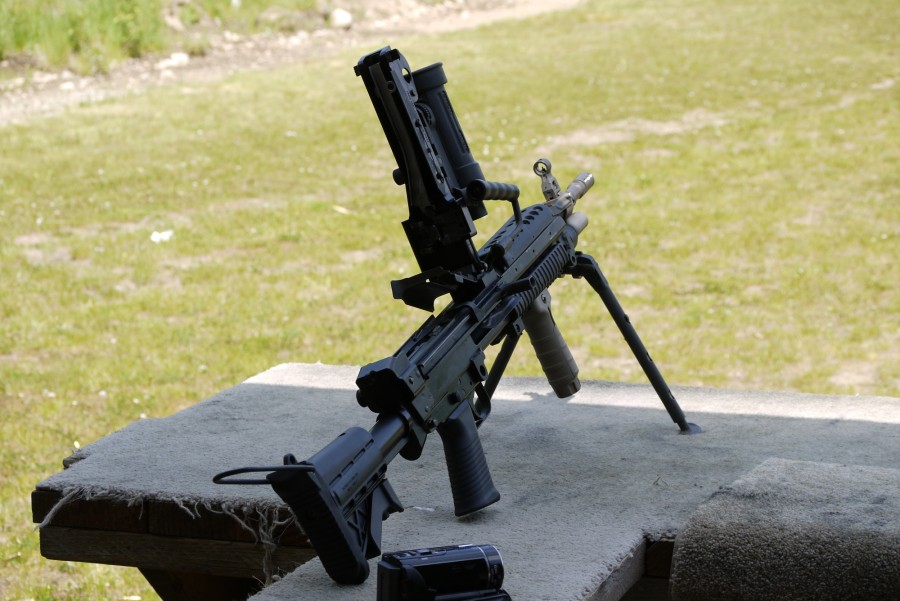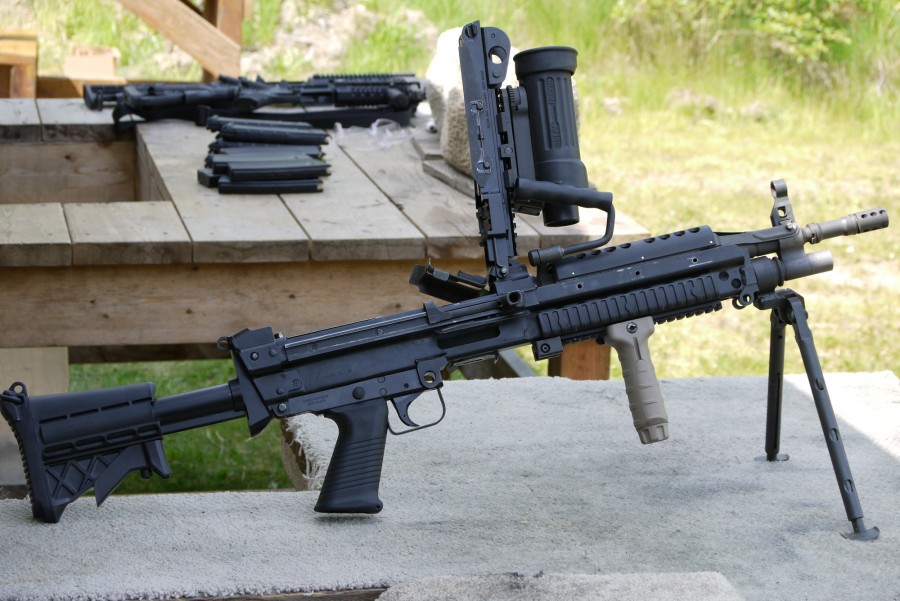There are moments in my firearms career that I am proud of and remember with great fondness. Hitting the 10 ring from 1,000 yards away on the first shot. Scoring 4 headshots on delicious animals with a 100% accuracy rate. Out-shooting (albeit for a brief glimmer of a moment) the Marine Corps Rifle Team. This…this was not one of those moments . . .
The video pretty much says it all.
I see that second so clearly in my mind. My “muscle memory” kicked in and told me to rack the charging handle and as I was doing it my conscious brain suddenly realized what was going on. You can even see the guy sitting there next to me slowly shake his head in disappointment.
I’m sitting here cringing just thinking about it.
I was sitting behind a loaded M249. The camera was rolling. I was rocking my awesome sunglasses. It was a prime opportunity to look really cool on video and I absolutely blew it.
Oh well. Doesn’t matter…went full auto anyway.
For those who are curious, the M249 PARA is the shortened version of the M249 SAW or Squad Automatic Weapon (now renamed LMG or Light Machine Gun, I believe), shorter and lighter than its older brother. It is a belt-fed fully automatic firearm that commonly uses 200-round belts of 5.56x45mm NATO ammunition, although the guys at the range were bragging about their 300 AAC Blackout version as well. The original design was by Fabrique National Herstal (FNH), but U.S. manufacturers have taken over the production of these guns for the military.
This is the current favorite firearm for the U.S. Army, providing excellent firepower for their small squads of soldiers. The Marine Corps uses these as well, but are in the process of replacing them for combat troops with the M27 Infantry Assault Rifle.






As an AR and semi-auto shotgun enthusiast who has never fired one of these, I can’t say that I wouldn’t do these same. It’s in our muscle memory to rack the charging handle before pulling the trigger.
Honestly I didnt even note what you did wrong until seeing ry’s post.
Oh well.. live and learn…
The Marines adopted the SAW first over the objections of the army who thought the ergonomics were bad, among other complaints. It’s funny now that the army likes it and the Marines are replacing it with a much smaller and less capable weapon.
I asked my battalion Gunner why and his answer is that it is because despite the official policy, in practice we make the junior Marine the automatic rifleman and we don’t train them properly to use a light machine gun. The tendency, then, is to waste a lot of ammo without getting the full effect of a machine gun. Battalions will keep some, but not many.
I’m not sure I agree with this change.
What are they switching to?
Full disclosure: never served.
But I have to ask: If giving a specific weapon to the junior guy makes the weapon ineffective, or at least inefficient, what sense is there in giving the guy the weapon? Is this one of those traditions where the guy with the most time to go before mustering-out gets to be the biggest target?
The SAW is supposed to be carried by the second most senior Marine in each fire team. In reality, because they’re heavy, they’re usually given to the new guys. My last unit actually did a pretty good job of not doing that, but they were the exception.
As a former Marine, but not a grunt I assumed that this was going to be the answer. Nobody like to hump a bunch of extra weight.
No you’re wrong. The SAW is a good weapon, but the IAR is better. The IAR is a more familiar platform for 0311s, and has the same capabilities as the SAW. The ONLY downside is the amount of ammunition in one magazine as opposed to one belt. I’ve fired both, and the IAR holds a better MOA, has the versatility to be a single shot weapon , is closed bolt (meaning it can be first in a stack to enter a room), and is much lighter and would be much easier to patrol with.
Don’t worry about it, Nick. The firing line that day was somewhat of an intimating place. There are tons of people watching you, and everybody is trying hard not to screw something up and look like a noob. I even forgot to send the bolt forward on one of the Colt M-4s I was shooting – and that general weapon system is one that I have probably put well over 100,000 rounds through. Go figure.
“There are tons of people watching you, and everybody is trying hard not to screw something up and look like a noob.”
I have found that absolutely fearlessness to ask the stupidest questions and to approach firearms skills with a child-like tabula rasa is the best and fastest way to improve. I am one of the better shooters in my club, but always ask the even better shooters more stupid questions than the new shooters. I think this is why women learn to shoot well faster than men, because they are not distracted with hiding initial incompetence. This is why kids learn foreign languages faster than adults…it has nothing to do with brain chemistry, and everything to do with not giving a crap that you sound like an idiot when you talk, which would otherwise keep you from trying and practicing.
Sorry for the rant, just one of my pet peeves in life.
Right you are, JM. The only dumb question is the one you didn’t ask.
“Scoring 4 headshots on delicious animals with a 100% accuracy rate.”
All meat dishes taste better with Ralph’s Cornbread Stuffing with Sage recipe. I think it’s time for Ralph to post it.
Aharon, you are relentless. Fortunately, I am a rock, I am an island.
Ok, coming from a complete noob here, why exactly was it wrong to charge the handle? Don’t to have to rack it to get the first round it?
Its an open bolt firearm, meaning that the first round doesn’t need to be chambered for it to fire. It just needs to be on the feed ramp.
The SAW fires from the open bolt, and proper loading procedure is to lock the bolt back and place it on safe before you load it. The charging handle is non-reciprocating and to avoid damage you push the handle back forward after charging. This is the condition the gun was in before he pulled the handle.
TL;DR – He basically tried to charge a gun that was already charged.
Gotcha, thanks.
It’s not necessarily an approved practice, but I know that a lot of gunners on open bolt weapon systems will ride the bolt forward then put the belt on the feed try. When ready to fire they pull the charging handle. Open bolt weapons when handled improperly have a tendency to occasionally go off when you don’t want them to. I think half the negligent discharges I’ve witnessed involve either M240 or M249s, despite the fact they represent less than 10% of the weapons in the inventory.
I don’t officially approve of the practice mind you, because who am I, a mere former battalion commander and current Division G3 to approve of something that the might warriors of TRADOC (the Training and Doctrine Command) don’t approve, but I certainly never discouraged it, especially among non combat arms types.
Thats how most guys carry, in Amber. Absolutely safe as long as they didn’t half-cock it and place it on safe with the bolt forward. That’s the reason for most of the open bolt NDs I’ve seen.
and when you’re running the charging handle on a 249, always PALM UP!
I hated the SAW in training. It looked and felt like cheap pot metal, and just didn’t feel like something that could reliably feed ammunition and send rounds toward the bad guys. Part of this, I realized later, was that the weapons in training were… tired.
I carried one for the last 4 or 5 months of 2006, and the only time I needed it, it put a few boxes of 5.56 downrange with no malfunctions of any kind after a long, dusty day in the turret. I think I still have a picture up from that day.
Was raised on the “pig”, the M60 MG. Learned to load only from an open bolt. And for certain, “palm up” was mandatory. I do have a question, though. Does anyone still teach indirect, observed, fire by MG teams? By the way, I loved the pig, specially the M60E3.
In leghorn’s defense, the bolt shouldn’t have been locked to the rear when loading.
The C6 (Canadian version of M249 (of sorts)) is also open bolt, and the load procedure is to open the feed cover, place ammo belt into position and then close feed cover. You cock the weapon when ready to shoot. You can have rifles cocked and on safe, but with the lmg it is better to leave uncocked unless you are expecting imminent danger.
And palm down.
Depends who you ask though.
Source: Cdn Army, 9 years an Engineer.